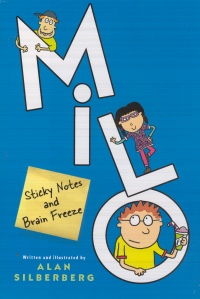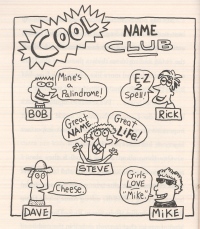| ________________
CM . . . . Volume XVII Number 35. . . .May 13, 2011. 
 |
Milo: Sticky Notes and Brain Freeze.
Alan Silberberg.
New York, NY: Aladdin (Distributed in Canada by Simon & Schuster Canada), 2010.
275 pp., hardcover, $18.99.
ISBN 978-1-4169-9430-5.
Subject Headings:
Grief-Fiction.
Death-Fiction.
Mothers-Fiction.
Friendship-Fiction.
Grades 5-9 / Ages 10-14.
Review by Keith McPherson.
***/4
|
| |
|

excerpt:
”Your mom is sick,” my dad finally says, and at first I wonder what the fuss is about - we all get sick. In fact I threw up just two weeks ago and had to eat chicken broth and crackers for two whole days, so I think, So what? Then I sneak a quick look at my mom and she’s still smiling and she looks okay, so I really wonder if this is some sort of joke.
“What do you mean, ‘sick’?” my sister asks, and because she’s older, I think maybe she sees through the haze and can tell something real is happening even while I pretend is isn’t.
Nobody answers, and suddenly I’m fidgeting too. “I want to go back to my show,” I say, pleading…My mother reaches for my shoulder and her touch makes me stay, and when I look up in her face, I see a hint of tears and then it hits me so hard that I freeze inside because SOMETHING IS WRONG.
Milo: Sticky Notes and Brain Freeze is a story about Milo Cruickshank, a grade seven boy who has recently lost his mother to brain cancer. It tells of the struggles Milo endures at school, at home, and in the community as he, his sister, and his father face everyday events, issues, and friends without the presence and guidance of their mother (or wife). Unfortunately, Milo’s father seems to be avoiding the topic with Milo (and vice versa) as both craft their conversations so that Milo only has to give his dad one or two word answers (e.g., Nope”, Uh-uh”, I dunno”, and “Okay”), which, according to Milo, is “way easier than actually taking about real stuff”.
 Through the caring of his best friend, Marshall, and the persistence of the ‘girl he doesn’t want to connect with’, Milo begins to engage with his confusing feeling and thoughts associated with his mother’s death, and he risks opening himself with other people again. This leads to the beginning of Milo’s acceptance and an initial understanding of the magnitude of change that losing a mother has had both on himself and his family. Through the caring of his best friend, Marshall, and the persistence of the ‘girl he doesn’t want to connect with’, Milo begins to engage with his confusing feeling and thoughts associated with his mother’s death, and he risks opening himself with other people again. This leads to the beginning of Milo’s acceptance and an initial understanding of the magnitude of change that losing a mother has had both on himself and his family.
Readers may quickly lose interest in the story over the first few chapters, especially if they have not read a summary of the novel on the dust jacket. Indeed, because I didn’t read this dust-jacket summary and had little idea that the story was about the death of a child’s mother, I felt like putting the book down by chapter 3. I found the protagonist to be uncomfortably immature, and I felt uneasy experiencing the world through his confused, shallow, and almost scatter-brained point-of-view. However, I highly recommend readers tough it out until chapter four and five when they will become aware of the reasons for seeing the world through Milo’s ‘fog-like’ state.
Told through the first person narrative, Milo: Sticky Notes and Brain Freeze would likely appeal to preteen boys who could relate to Milo’s feelings, comments, and perceptions (I had a preteen girl read this novel, and she quit reading it midway through, calling it a “book for boys” and saying that “it doesn’t interest me”). More specifically, Milo could be used by parents and counselors wishing to help preteen boys come to terms with the loss of a parent, especially a mother.
The story is illustrated with black and white drawings that have a very strong cartoon nature to them. These images add visual humour and alleviate the tension associated with the story’s heavy content. Additionally, the images extend the story and add critical information. For example, on page 233, Milo finally faces the truth that his mother is gone and will not be returning. The supporting images depict some ‘helping’ hands wrapping a blanket around Milo and providing him comfort by tucking him in (like his mother used to do), using the very blanket that covered Milo’s mother on her deathbed.
Milo: Sticky Notes and Brain Freeze contains many short chapters and can be used as a quick easy read aloud. The characters are realistic and revealed in all their failings and strengths. For example, Milo’s father is seen as a caring and loving father who tries his best to keep his job going and pick up the slack of Milo’s mother, but he also is portrayed as having as much difficulty as Milo in dealing with the loss of his wife (Milo’s mother). Additionally, as the story progresses, I found myself cheering Milo on as he began to move beyond denial and anger of his mother’s death towards healing through celebrating the past and growing through thoughtful reflection with his friends and family.
Milo: Sticky Notes and Brain Freeze is a touching story about the profound changes the loss of a mother can have on a preteen boy and his family. Although most girls may not relate to the content as readily as boys, and the confusing nature of the first few chapters may turn some readers off, I recommend persistence as this novel will deliver a heartfelt read that will stay with you for weeks.
Recommended.
Keith McPherson has been an elementary teacher and teacher-librarian in BC since 1984, and he is currently a lecturer for the Department of Language and Literacy Education at the University of British Columbia in Vancouver, BC.

To comment on this title or this review, send mail to
cm@umanitoba.ca.
Copyright © the Manitoba Library Association. Reproduction for personal use is permitted only if this copyright notice is maintained. Any other reproduction is prohibited without permission.
NEXT REVIEW |
TABLE OF CONTENTS FOR THIS ISSUE- May 13, 2011.
AUTHORS |
TITLES |
MEDIA REVIEWS |
PROFILES |
BACK ISSUES |
SEARCH |
CMARCHIVE |
HOME |

 Through the caring of his best friend, Marshall, and the persistence of the ‘girl he doesn’t want to connect with’, Milo begins to engage with his confusing feeling and thoughts associated with his mother’s death, and he risks opening himself with other people again. This leads to the beginning of Milo’s acceptance and an initial understanding of the magnitude of change that losing a mother has had both on himself and his family.
Through the caring of his best friend, Marshall, and the persistence of the ‘girl he doesn’t want to connect with’, Milo begins to engage with his confusing feeling and thoughts associated with his mother’s death, and he risks opening himself with other people again. This leads to the beginning of Milo’s acceptance and an initial understanding of the magnitude of change that losing a mother has had both on himself and his family.